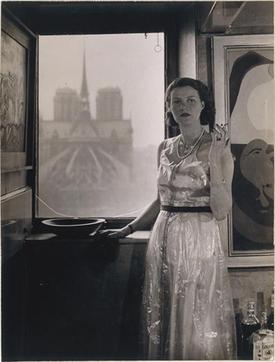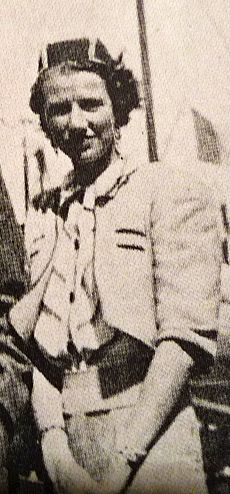Peggy Guggenheim facts for kids
Quick facts for kids
Peggy Guggenheim
|
|
|---|---|

Peggy Guggenheim, c.1930, Paris, photograph Rogi André (Rozsa Klein). In the background, Notre-Dame de Paris, and on the right, Joan Miró, Dutch Interior II (1928).
|
|
| Born |
Marguerite Guggenheim
August 26, 1898 New York City
|
| Died | December 23, 1979 (aged 81) Camposampiero, Italy
|
| Nationality | American |
| Known for | Peggy Guggenheim Collection |
| Spouse(s) | Laurence Vail (1922–c.1928) Max Ernst (1941–1946) |
| Parent(s) | Florette Seligman Benjamin Guggenheim |
Marguerite "Peggy" Guggenheim (guug-ƏN-hyme; August 26, 1898 – December 23, 1979) was an American art collector. She was known for finding and showing amazing modern art. Peggy came from the rich Guggenheim family in New York City. Her father, Benjamin Guggenheim, sadly died when the Titanic sank in 1912. Her uncle, Solomon R. Guggenheim, started the famous Solomon R. Guggenheim Foundation.
Peggy collected art mainly between 1938 and 1946 in Europe and America. She showed her collection as she bought new pieces. In 1949, she moved to Venice, Italy. She lived there and displayed her art for the rest of her life. Today, the Peggy Guggenheim Collection is a modern art museum in Venice. It is one of the most popular places to visit in the city.
Contents
Peggy Guggenheim's Early Life and Art Journey
Peggy Guggenheim's parents were both from Jewish families. Her mother, Florette Seligman, was part of the well-known Seligman family. When Peggy turned 21 in 1919, she received an inheritance of $2.5 million. Her father, Benjamin Guggenheim, did not have as much money as his brothers. Because of this, Peggy's inheritance was less than her cousins'.
Peggy first worked at an interesting bookstore in New York City called Sunwise Turn. There, she met many creative artists and writers. In 1920, she moved to Paris, France. She became friends with many new artists and writers. Many of them were not rich and lived in the Montparnasse area of the city. Famous artists like Man Ray and Marcel Duchamp became her friends. She later helped to show their art.
Peggy also became good friends with writer Natalie Barney and artist Romaine Brooks. She often visited Barney's special gatherings. She also met and became friends with writer Djuna Barnes. Peggy even helped Barnes by renting a country house for her to write her famous novel, Nightwood.
Peggy Guggenheim also encouraged Emma Goldman to write her life story. She helped Emma get money to live in France while writing her book. Peggy wrote her own life story called Out of This Century. It was later updated and published as Confessions of an Art Addict.
Starting Her Art Collection Before World War II
In January 1938, Peggy Guggenheim opened her own modern art gallery in London. It was called Guggenheim Jeune. The first show featured drawings by Jean Cocteau. Peggy often bought at least one artwork from each show at her gallery. When World War II began, she started buying as much abstract and Surrealist art as she could.
The name Guggenheim Jeune was clever. It linked her gallery to a famous French gallery, Bernheim-Jeune. It also used her own well-known family name. Her gallery on Cork Street was successful. Many friends gave her advice and helped her run it. Marcel Duchamp, whom she had known since the 1920s, helped her a lot. He taught her about modern art and helped plan many of the shows.
After the Cocteau show, Guggenheim Jeune featured art by Wassily Kandinsky, Yves Tanguy, and Wolfgang Paalen. Peggy also held group shows for sculptures and collages. These shows included works by famous artists like Henry Moore, Alexander Calder, Max Ernst, and Pablo Picasso. She also greatly admired the work of John Tunnard and helped him become known around the world.
Peggy's Dream for a Museum
Peggy realized that her gallery, even though it was popular, lost money in its first year. She decided to use her money in a different way. She thought about opening a museum for modern art. Her uncle, Solomon R. Guggenheim, had already started the Solomon R. Guggenheim Foundation in New York City. His foundation aimed to collect and promote abstract art. This led to the opening of the Museum of Non-objective Painting in 1939.
Peggy closed Guggenheim Jeune in June 1939. She started planning a Museum of Modern Art in London with art historian Herbert Read. She set aside $40,000 for the museum's costs. However, the plans became too big for the money she had.
In August 1939, Peggy went to Paris to arrange for artworks for the first exhibition. She had a list from Herbert Read. But soon after she arrived, World War II started. This made her change her plans. She then decided to buy paintings by all the artists on Herbert Read's list. She had a lot of time and money, so she aimed to buy one painting each day. She ended up buying 10 Picassos, 40 Ernsts, eight Mirós, and many other important works.
She also made new plans for a museum in Paris. But a few days before the Germans reached Paris, she had to leave. She fled to the south of France. After months of keeping her art and artist friends safe, she moved to New York in 1941. The next year, she opened a new gallery and museum at 30 West 57th Street. It was called The Art of This Century. This space had four galleries. Three were for Cubist, Abstract, and Kinetic art. The fourth was a commercial gallery where art was sold. Peggy also held important shows there, including one for 31 women artists.
Her interest in new art helped many important modern artists. These included American painters Jackson Pollock and William Congdon, and German painter Max Ernst. She married Max Ernst in December 1941. Peggy collected all these artworks in just seven years.
The Peggy Guggenheim Collection in Venice
After World War II and her divorce from Max Ernst in 1946, Peggy closed her gallery in New York. She moved back to Europe and chose to live in Venice, Italy. In 1948, she was asked to show her collection at the Venice Biennale, a big art exhibition. In 1949, she moved into the Palazzo Venier dei Leoni, a beautiful unfinished palace on the Grand Canal.
Her collection became one of the few in Europe to show many works by American artists. In the 1950s, she supported local painters like Edmondo Bacci and Tancredi Parmeggiani. By the early 1960s, Peggy had mostly stopped buying new art. She focused on showing the art she already owned. She loaned her collection to museums in Europe. In 1969, she loaned it to the Solomon R. Guggenheim Museum in New York City, named after her uncle.
Eventually, Peggy decided to give her home and her art collection to the Solomon R. Guggenheim Foundation. This gift was completed in 1976, before she passed away in 1979.
Today, the Peggy Guggenheim Collection is one of Italy's most important museums. It features European and American art from the first half of the 20th century. The collection includes art styles like Cubism, Surrealism, and abstract expressionism.
Peggy lived in Venice until she died in Camposampiero, Italy, after a stroke. Her ashes are buried in the garden of her home, the Palazzo Venier dei Leoni. Her beloved Lhasa Apso dogs are also buried there.
Peggy Guggenheim's Family Life
Peggy Guggenheim was married twice. Her first husband was Laurence Vail, a sculptor and writer. They had two children, Michael Cedric Sindbad Vail and Pegeen Vail Guggenheim. They divorced in 1928. Her second husband was the painter Max Ernst. They married in 1941 and divorced in 1946. One of her grandchildren, Karole Vail, became the director of the Peggy Guggenheim Collection in 2017.
Images for kids
-
Guggenheim's grave, with a plaque remembering her Lhasa Apsos (dogs)
See also
 In Spanish: Peggy Guggenheim para niños
In Spanish: Peggy Guggenheim para niños



